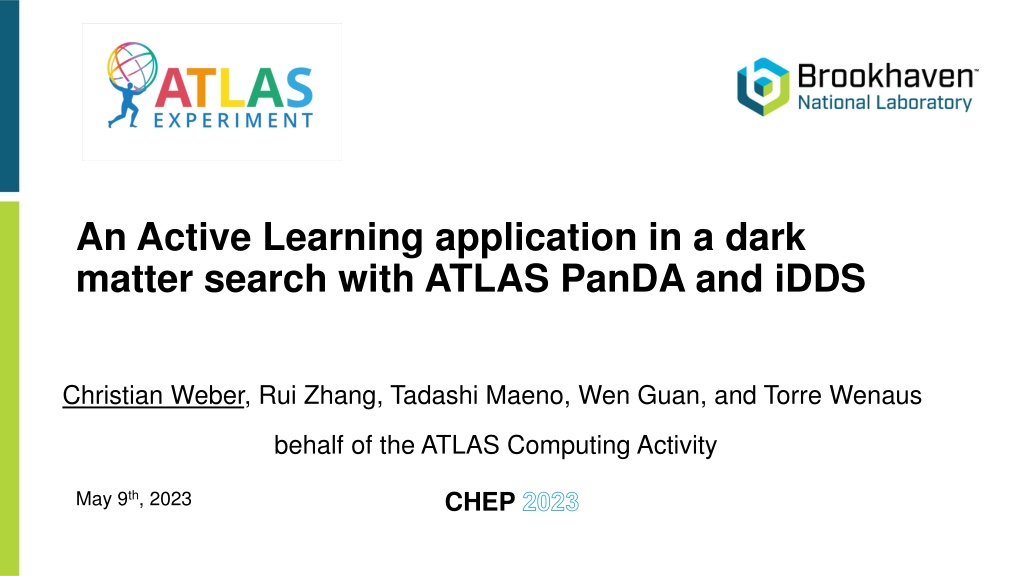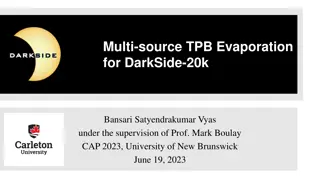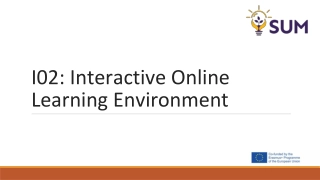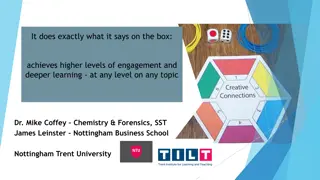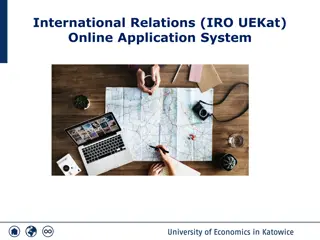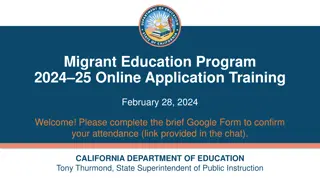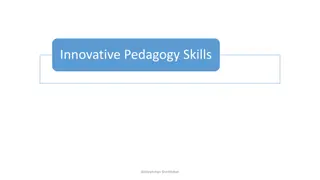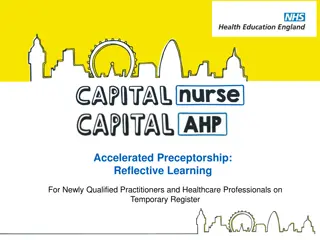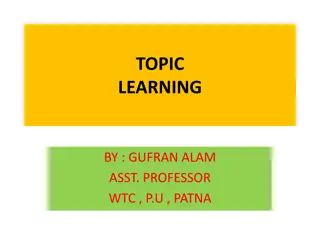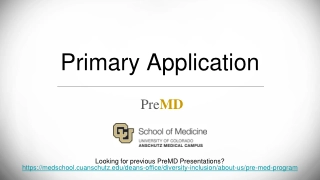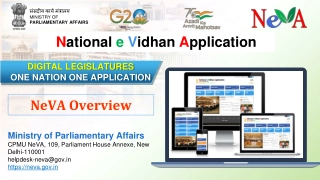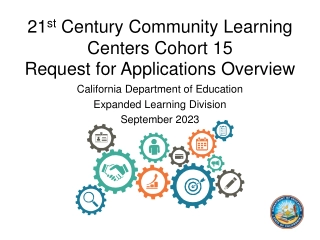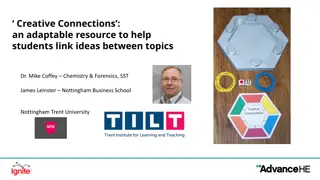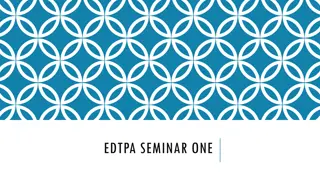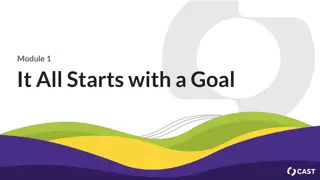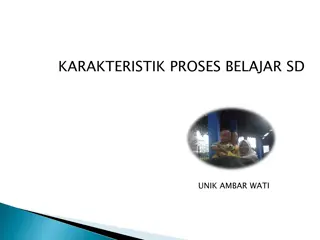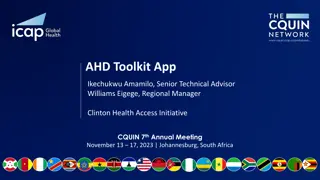Dark Matter Search with ATLAS: Active Learning Application
Explore an active learning application in the search for dark matter using ATLAS PanDA and iDDS. Investigate Beyond Standard Model physics parameters related to Hidden Abelian Higgs Model and New Scalar with a focus on cross-section limit calculations. Understand the process for generating Monte Carlo events, calculating limits in multidimensional parameter space, and managing Monte Carlo simulation CPU resources for the ATLAS experiment.
Download Presentation
Please find below an Image/Link to download the presentation.
The content on the website is provided AS IS for your information and personal use only. It may not be sold, licensed, or shared on other websites without obtaining consent from the author. Download presentation by click this link. If you encounter any issues during the download, it is possible that the publisher has removed the file from their server.
Presentation Transcript
An Active Learning application in a dark matter search with ATLAS PanDA and iDDS Christian Weber, Rui Zhang, Tadashi Maeno, Wen Guan, and Torre Wenaus behalf of the ATLAS Computing Activity CHEP 2023 May 9th, 2023
Beyond Standard Model physics parameters Hidden Abelian Higgs Model New Scalar ?, new vector boson ?? Five different parameters: ?? - new scalar mass ??? - new vector boson mass ?? - decay width of the new vector boson ? mixing between Standard Model ? and ?? ? mixing between Higgs Boson ? and ? In general, we would like to know what the associated cross section limits are for each combination of parameter values, or which combinations are excluded. 2
Cross section limit calculation Generate Monte Carlo (MC) Events for Standard Model backgrounds do this once using Standard Model parameters Signal process under the given signal model do once for every point in parameter phase space Apply selection for backgrounds and signal Profile Likelihoods for each simulated signal to find upper limits on the cross section ? ? = Pois Data?|??+ ?? ? JHEP03(2022)041 ? ??, ? dependent on physics parameters ??, ???, ??, ? , ? 3
Limits in multidimensional parameter space Process for calculation of limits in phase space conceptionally simple, e.g., do a grid search ? Select boundaries in ??, ???, ??, ?, Generate grid of signal samples And calculate cross section limits for each sample Bonus: with theory predictions one can infer contours between excluded and not excluded regions of parameter space Problem: Generating Monte Carlo samples is computationally expensive ??? 4
Monte Carlo Simulation CPU resources available to the ATLAS experiment in late January 2023 Monte Carlo (MC) Event simulation is very computationally intensive ~15h calculation time for 100 simulated events on a single CPU core #CPU cores Might need around 105 events or more per signal sample Using a grid of 10 values in two dimensions would require 107 events, about ~2k CPU months Estimate is for fast calorimeter simulation, full calorimeter simulation requires even more computational resources ATLAS experiment time [Month/Day] 5
Active Learning An iterative process to collect new labelled data for optimization tasks We developed a system to work around the computational constraints by using an Active Learning approach that includes Surrogate model that approximates the function mapping physics parameters onto exclusion limits ??,???, ??,?,? ???,???, ??,?,? An acquisition function that determines which points in the physics parameter space, e.g. ??,???, ??,?,?, to explore next based on the surrogate model 6
Active Learning Application Our system builds on ATLAS grid infrastructure to enable the application of the active learning in the exploration of the parameter phase space It is realized via the intelligent data delivery service (iDDS) that allows a docker container instance to effect the simulation Monte Carlo samples on the ATLAS grid, run an analysis on REANA, and exchange data between them iDDS The iDDS is a computing service that allows for on-demand data transformation and granular data delivery within the ATLAS grid PanDA is the Production and Distributed Analysis workload management system for the ATLAS grid REANA is a platform enabling workflow preservation and reuse of data for analysis See also yesterday s talk: Distributed Machine Learning with PanDA and iDDS in LHC ATLAS 7
Surrogate Model Surrogate Model: Gaussian Process Non-parametric model, yielding probability distribution over possible functions that fit a set of points. Assumes output ?(?) is a random variable for each input ? and ? ? ?1,? ?2, is a multivariate gaussian: ? ?( ?) = ? ? ? | ?,? mean vector ??= ? ?? covariance matrix ???= ? ??,?? kernel ?, many options, common choice: Radial Basis Function kernel 2 ?? ?? 2?2 ? ??,?? = exp 8
Surrogate Model & Acquisition Function Acquisition Function: Probability of improvement Assume we want to find the minimum of an underlying true function, via optimizing surrogate model ? ? is current minimum, then choose next value to sample for surrogate model, such that PI ? = Prob ? ? ? ? < 0 is maximal PI ? calculable as ? ? is a gaussian distribution with mean ? ? , and standard deviation ? ? ? ? ?(?) ?? ? = ? ? Gaussian cumulative distribution function See Active Learning for Excursion Set Estimation by Kyle Cranmer et al. for an entropy-based acquisition function 9
Iterative feedback & learning start with 7 random initial points 7 initial points + 1 predicted point 7 initial points + 3 predicted point 7 initial points + 2 predicted points 10
Production Interface 11
Dark Matter Search Demonstrate active learning pipeline on one of the analysis channels from JHEP03(2022)041: Search for Higgs bosons decaying into new spin-0 or spin-1 particles in four-lepton final states with the ATLAS detector with 139 ?? 1 of ?? collision data at ? = 13 TeV ? ???? 4? ? ???? 4 ? ??? 4 01 GeV < ??? < 15 GeV 15 GeV < ???< 60 GeV 15 GeV < ???< 55 GeV Low-mass (LM) targeting Higgs portal High-mass (HM) targeting Higgs portal Single ? boson (ZX) targeting hypercharge portal Focusing on ZX channel Original analysis performed 1D scan in ??? Extend to 2D scan in ??? and ? JHEP03(2022)041 12
JHEP03(2022)0412 Verify MC Production & Analysis Chain Slight difference in MC Production and Analysis setup with respect to published analysis at: JHEP03(2022)041 Slightly different MC production setup Smaller amount of MC statistics 10k vs ~200k Check against published cross section limit values on HEPData JHEP03(2022)041 Agreement within 4% - good! 13
Parameter phase space bounded by 15 ??? 55 GeV 10 4 ? 10 1 Run in 4 iterations with 30 points total 2D Demonstration ATL-PHYS-PUB-2023-010 14
Conclusion Demonstrated active learning driven re-analysis for published dark sector analysis see ATLAS PubNote ATL-PHYS-PUB-2023-010 Extended ZX analysis channel from 1D to 2? parameter space in ??? and ? Preparing second demonstrator based on heavy Higgs Boson search 3D parameter space theory predictions to prioritize exclusion contours ATL-PHYS-PUB-2023-010 Many other applications and possibilities for this tool and workflow Another ATLAS application of active learning using a different tool: Active Learning reinterpretation of an ATLAS Dark Matter search constraining a model of a dark Higgs boson decaying to two ?-quarks ATL-PHYS-PUB-2022-045 A search for heavy Higgs bosons decaying into vector bosons in same-sign two-lepton final states in ?? collisions at ?=13 TeV with the ATLAS detector Talk later today at 17:30 by Zubair in Track 9 Efficient search for new physics using Active Learning in the ATLAS Experiment 15 arXiv:2211.02617
The End. Thank you! 16
